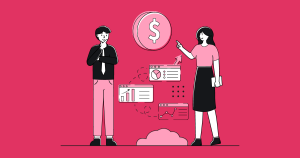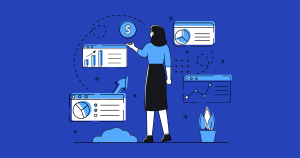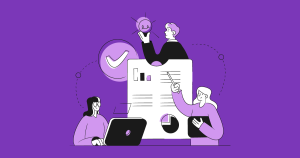Balance sheet – how to read and use a balance sheet
- March 15, 2023
- 5 min read
Let’s get straight into it – a balance sheet is like a snapshot of your own money situation.
It shows what you own (your assets such as cars, furniture, art, house), what you owe (your liabilities such as credit card debt, mortgage, car loan), and how much is left over after you pay off what you owe (your shareholder’s equity).
And just like a balance sheet shows your money situation at a certain point in time, a balance sheet for your business shows your financial situation at a certain point in time.
Your business might have assets like money in the bank, products to sell, and buildings it uses.
It might also have liabilities like loans it needs to pay back and bills it owes to suppliers.
And the shareholder’s equity is what’s left over after your business pays off all its liabilities, or how much the owners of your business have invested in it.
Got it? Enough talk.
Overview:
- What is the balance sheet?
- Why is it called a balance sheet?
- The structure of the balance sheet
- How to read a balance sheet
- How to use the balance sheet
- What’s the Sleek Scoop with balance sheets?
What is the balance sheet?
A balance sheet is a financial statement that shows a company’s assets, liabilities, and equity at a specific point in time.
It provides a snapshot of the financial position of a company and is used to assess its ability to pay debts and meet financial obligations as part of international financial reporting standards.
Why is it called a balance sheet?
Because it must balance! The balance sheet equation is –
Total assets equal the sum of total liabilities and total equity.
It is one of the generally accepted accounting principles where the equation represents the idea that a company’s assets are funded by either debt (liabilities) or equity.
The structure of the balance sheet
So, what does a balance sheet look like? The structure of a balance sheet will be the same for every business.
The structure of a balance sheet follows the formula – Assets = Liabilities + Equity:
Assets
This first section lists your company’s resources, including current assets such as how much cash and cash equivalents, accounts receivable, investments, property, plant, equipment, and any other assets.
Liabilities
The next section, liabilities, lists your company’s obligations, including accounts payable, loans, bonds, current liabilities and other debts.
Equity
The final section, the equity section lists your shareholders’ equity – this is the company’s ownership, including common stock, retained earnings, and any other equity items.
It might still just look like a whole bunch of numbers, so we’re going to show you how to read your balance sheet.
How to read a balance sheet
We will now go through each line of the balance sheet, so if you have your company’s balance sheet in front of you, use that to follow.
This will make it so much easier to understand.
Let’s break it down.
Starting at the top with assets – the first section of the balance sheet.
Assets
Remember, your assets in a balance sheet represent your company’s resources, things of value that it owns and has at its disposal to generate income or meet obligations.
If you follow the balance sheet assets, they are typically classified into several categories in order of liquidity – liquidity being the ease with which they can be converted.
The main categories of assets in a balance sheet are:
Current assets
These are assets that can be converted into cash within one year, such as cash, petty cash, accounts receivable, marketable securities, and inventory.
Fixed assets
These are long-term assets used in a business, such as property, plant, and equipment.
Intangible assets
These are non-physical assets, such as patents, trademarks, and copyrights.
Other assets
This category includes any other assets that do not fit into the other categories, such as prepaid expenses and investments in other companies.
The total equals the company’s total assets.
Next up, are your business’ liabilities – the money it owes.
Liabilities
Liabilities can be in the form of money owed your business owes to suppliers, loans from banks, or bonds issued to investors. Liabilities can be short-term or long-term, depending on when the company expects to repay the debt.
They are listed in the balance sheet in order of their maturity, with current liabilities listed first, followed by long-term liabilities and other liabilities.
The main categories of liabilities in a balance sheet are:
Current liabilities: these are short-term debts that the company expects to pay off within one year, such as accounts payable, credit cards, short-term loans, and taxes owed.
Non-current liabilities: these are debts that the company expects to pay off over a period of time greater than one year, such as long-term loans and bonds.
Other liabilities: this includes any other liabilities that do not fit into the other categories, such as deferred taxes and pension obligations.
Lastly, is shareholders’ equity.
Shareholder equity
Shareholder equity, also known as stockholders’ equity, represents the ownership interest in your company.
Simply, the amount that would be returned to shareholders if all the assets of a company were sold and all its debts were paid off.
The main components of shareholder equity in a balance sheet include:
Common stock: This is the basic form of ownership in a company, representing the ownership claims of common shareholders.
Preferred stock: This is a type of stock that has priority over common stock in the payment of dividends and the distribution of assets in the event of a liquidation.
Retained earnings: This represents the portion of a company’s net income that has not been paid out as dividends, but instead has been kept in the business and reinvested.
Treasury stock: This represents the number of shares of stock that a company has bought back and is holding as an investment.
Other equity: This includes any other equity items that do not fit into the other categories, such as unrealized gains or losses from investments and equity from convertible debt.
How to use the balance sheet
As a business owner, now you know how to read a balance sheet, we’re going to show you how to apply this information to gain valuable insights into your company’s position and performance.
Take your time through each step, as it will give more meaning to the figures in your balance sheet:
Familiarise yourself with the layout:
A balance sheet typically has three sections: assets and liabilities + shareholder’s equity. Assets your company owns are listed first (current assets then non-current assets – fixed, tangible and other), followed by liabilities and shareholder’s equity.
Look for trends:
Compare the balance sheet of your company over time to see if there have been any significant changes, such as an increase in liabilities or a decline in assets.
Contextualise the information:
Keep in mind that the balance sheet only provides a statement of financial position at a single point in time. To fully understand a company’s health, you should also review its income statement, cash flow statement, and other financial reports.
Got it now? We knew you would!
What’s the Sleek Scoop with balance sheets?
When reading and analysing your business’ balance sheet, Sleek recommends you keep these things in mind –
Timing
As your balance sheet is a snapshot of a company’s position at a specific point in time, it’s important to consider the date when it was prepared and what was happening within the business and externally at the time.
Completeness
A balance sheet should include all significant liabilities and assets the business owns, so review it carefully to ensure that all important information has been included.
Balance
The balance sheet should balance – total assets equal to the sum of liabilities and shareholder’s equity. If this is not the case, there may be errors or omissions that need to be corrected.
Trends
Analysing changes in your balance sheet over time can provide insights into its financial performance and growth. For example, if your company’s liabilities are increasing faster than its assets, it may indicate that it’s having trouble managing its debt.
Use with other financial statements
A balance sheet should be used in conjunction with other financial statements, such as the income and cash flow statement, to gain a complete picture of your company’s position and performance.
So, a balance sheet is a handy tool to keep track of your assets, liabilities, and shareholder’s equity, and make sure your business is geared up for business.
Do you need more help reading and analysing your business’ balance sheet – just ask our Sleek accountants, they love them! Call now on +61 2 9100 0480 or use our chat box in the bottom right-hand corner.






